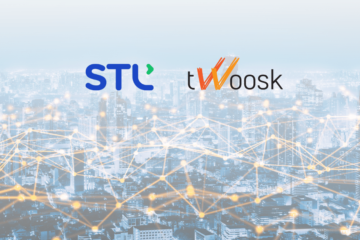
The telecom industry is set to embark on a transformative journey in 2024, characterized by rapid technological advancements, evolving market dynamics, and a shift toward more innovative, customer-centric, and sustainable practices. This extensive exploration delves into the multifaceted trends and expectations shaping the telecom sector in 2024, drawing from the latest insights and expert predictions.
The Evolution and Expansion of 5G
The expansion of 5G technology is poised to be a defining feature of the telecom landscape in 2024, with significant implications for connectivity, services, and industry standards.
5G’s Transformative Growth:
2024 will witness the transformative growth of 5G, marking its shift from an emerging technology to a critical component of global connectivity. This evolution is expected to catalyze a host of new applications and services, reshaping various sectors with enhanced mobile broadband and innovative IoT solutions.
Groundwork for 5G and 5G SA:
The development of 5G Standalone (SA) networks will continue to be a pivotal aspect of 5G’s evolution. Investments in network infrastructure, such as densification and fiber rollout, are essential for harnessing the full potential of 5G.
5G Becomes Mainstream:
The mainstream adoption of 5G in 2024 will signify a major leap in connectivity. The surge in global 5G subscriptions is set to reshape how businesses and consumers interact with technology, ushering in a new era of digital communication.
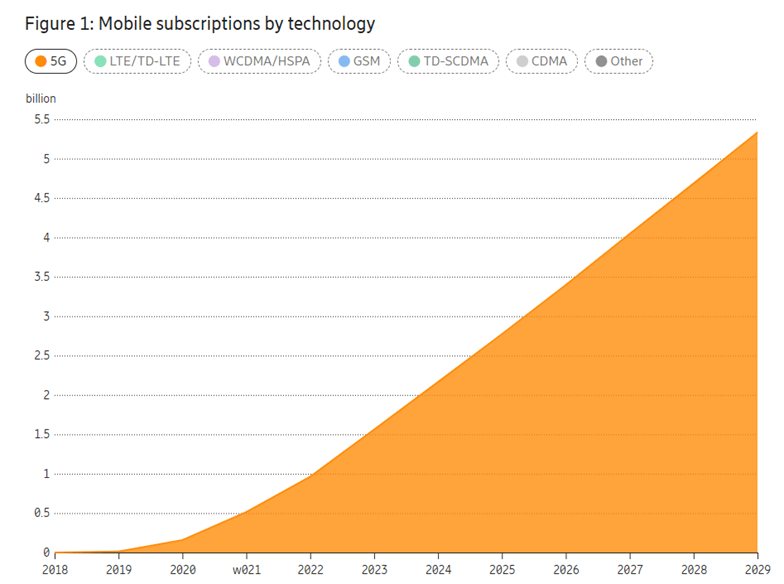
Fiber Optic Innovations and Expansions
In 2024, significant developments in fiber optics are anticipated, contributing to greater bandwidth and enhanced communication capabilities. These advancements are not merely about meeting the increasing data demands of modern networks and applications; they represent a shift towards creating a more interconnected and robust network capable of supporting the growing needs of data-driven technologies and services.
The expansion of fiber optic infrastructures will play a crucial role in supporting the growth of high-speed internet and next-generation telecom services. Investments in fiber technology are becoming pivotal, enabling faster, more reliable connectivity. This expansion is a strategic move towards improving network speed and efficiency, making fiber optics an essential component of the telecom sector’s growth strategy.
According to Polaris Market Research, the global fiber to the home market, valued at USD 53.88 billion in 2023, is projected to grow at a CAGR of 12.2% during the forecast period. This growth is fueled by the increasing demand for high-speed internet, technological advancements, and government support.
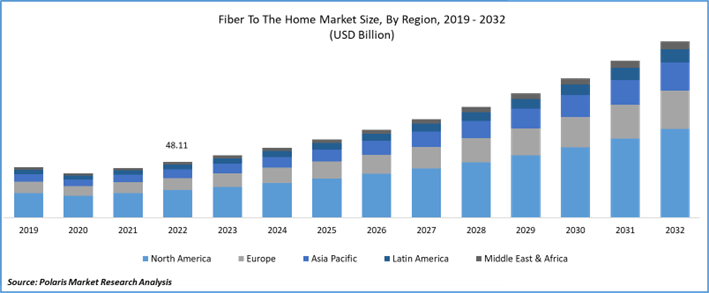
Growth of Data Centers and Cloud Services
Parallel to the advancements in fiber optics, the significance of data centers and cloud services in the telecom sector is becoming increasingly pronounced. This marks a shift towards more integrated and sophisticated IT solutions, essential for the digital age. The growth of data centers, driven by the need for cloud computing and data storage, is a notable trend for 2024. This expansion is crucial for managing the large volumes of data generated by both businesses and consumers. It is expected to be driven by the demand for more efficient data processing and storage solutions, catering to the increasing reliance on cloud-based services.
Moreover, the integration of data centers with telecom services is expected to become more pronounced, enhancing the efficiency and scalability of telecom operations. This synergy will pave the way for innovative cloud-based solutions and services, creating a more streamlined and effective ecosystem. The convergence of data centers and telecom services facilitates seamless information exchange and processing, bolstering the capabilities of the telecom industry in the digital economy.
Dirk Naylor, Senior Vice President and General Manager, USA & Global Accounts at WESCO, points out that data center operators are still catching up from the delays caused by COVID, with many projects having been on hold during the pandemic. He emphasizes that as AI continues to drive a rapid increase in demand and power, 2024 will see data centers in a sprint to keep up with technological demands, including a rise in modular data centers. According to Naylor, the technology is advancing at a rate that is currently outpacing data center construction. Furthermore, Holland Barry, SVP and Field CTO at Cyxtera, adds that data center providers will need to embrace advanced cooling technologies and explore new design schemes to effectively meet the requirements of next-generation technology.
Quantum Computing and AI Integration
The intersection of quantum computing and AI with telecom technologies will drive significant advancements and operational efficiencies in the industry.
Generative AI and Field Operations:
The integration of Generative AI will be a game-changer in telecom, offering significant cost reductions and efficiency improvements in network operations and field services, thus enhancing customer experiences and streamlining management processes.
According to Precedence Statistics, “The global generative AI in telecom market size was estimated at USD 150.81 million in 2022 and it is expected to hit around USD 4,883.78 million by 2032, growing at a CAGR of 41.59% during the forecast period from 2023 to 2032.”
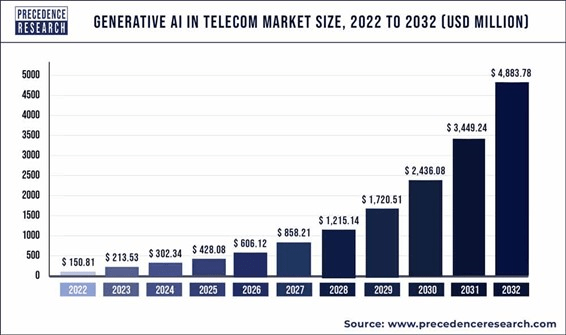
Quantum Computing’s Gradual Advancement:
While quantum computing is still in its nascent stages, its steady progress in 2024 will lay the groundwork for future breakthroughs, particularly in enhancing network security and efficiency.
Open RAN’s Progress and Challenges
Open RAN technology, despite facing challenges, is set to make significant strides in 2024, playing a crucial role in the evolution of network architectures and telecom services.
The continued progress of Open RAN technology in 2024, despite facing performance and interoperability challenges, underscores the industry’s commitment to more flexible and scalable network solutions.
The deployment of Open RAN at scale will mark a significant trend in the telecom industry in 2024. Its development will be key in overcoming early challenges and establishing a more diversified and innovative network environment.
The Onset of 6G Discussions
The commencement of discussions around 6G technology in 2024 will mark the beginning of a new chapter in wireless communication, setting the stage for future advancements.
Beginning of the 6G Race:
The initiation of discussions about 6G in 2024 will be a pivotal moment for the telecom industry. These early conversations will explore potential frequency bands and innovative use cases, laying the foundation for the next evolution of wireless technology.

B2B Focus in CSP Strategies
A strategic shift towards the Business-to-Business (B2B) segment by Communication Service Providers (CSPs) will redefine market approaches and service offerings in the telecom sector.
B2B at the Core of CSP Strategies:
In 2024, CSPs will increasingly prioritize the B2B segment, recognizing its potential to drive growth and innovation. This shift will lead to the development of new business models and solutions tailored to meet the demands of enterprise clients.
Rise of IoT Ecosystems and Extended Reality Applications
The convergence of IoT and Extended Reality (XR) technologies will open up new opportunities for innovation and enhanced connectivity across various sectors.
IoT Ecosystems Boosting Edge and P5G Adoption:
The integration of IoT with Private 5G and edge computing in 2024 will be a key driver in the telecom industry. This convergence will facilitate real-time insights and decision-making, emphasizing the growing significance of IoT ecosystems.
Extended Reality (XR) Gaining Traction:
The advancement of Extended Reality technologies in 2024 is set to bring about a wave of new applications. This progress will leverage enhanced connectivity to create immersive experiences across different industries.
According to Market.us, the extended reality market, currently valued at USD 49.6 billion in 2023, is projected to experience significant growth (USD 62.9 billion). With an anticipated Compound Annual Growth Rate (CAGR) of 30.8% from 2022 to 2032, the market is expected to surge to an impressive USD 519.5 billion by 2032.
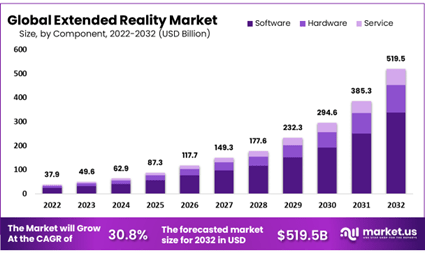
Sustainability Initiatives and Green Telecom
Sustainability will emerge as a central theme in the telecom industry in 2024, with companies increasingly adopting eco-friendly practices and technologies.
Sustainable Practices in Telecom:
In 2024, the telecom industry will place a stronger emphasis on sustainability. Companies will adopt green practices and technologies, reflecting a commitment to environmental responsibility and sustainable development.
According to Deloitte, telecom companies globally are set to decrease their carbon emissions substantially. It’s predicted that in 2024, there will be a 2% reduction in carbon footprint, equivalent to 12 million tons of CO2e, with a similar reduction anticipated for 2025.
As we look toward 2024, the telecom industry is poised for a year marked by groundbreaking technological advancements, strategic business shifts, and a renewed focus on customer-centric solutions and sustainability. This period represents an opportunity for the industry to embrace change, seize new growth opportunities, and enhance connectivity, reinforcing telecom’s role as a pivotal enabler in the global digital transformation.




